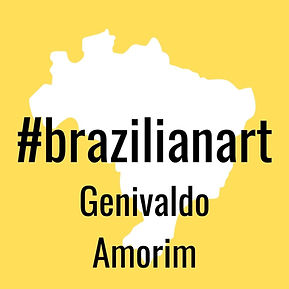FROM DRAWING TO SHARING – INTERVIEW WITH GENIVALDO AMORIM
Genivaldo Amorim is the second artist we decided to interview for #brazilianart, and it was not a random choice, because he represents the opposite art, in some ways, to that of Sergio Adriano H.
Born in the state of Parana in southern Brazil, he moved very young to the neighboring state, Mato Grosso do Sul, where he grew up. At the age of 18, he and his parents arrived in Valinhos in the state of São Paulo, where he still lives and works.
Art came into his life while he was still young, thanks to one of his teachers, who encouraged him to start drawing-"I who had never entered a museum, had never seen an exhibition..." - so he decides to take a postal course in drawing; but it is only when he arrives in Valinhos and visits his first exhibition that he discovers for the first time what art really is.
The beginning of his production is made up of drawings and portraits, then he moves on to the abstract, and finally arrives at installation.
Genivaldo's works are constantly evolving, rarely do his projects have a beginning and an end, if he is not satisfied with a work he changes it even if that work has already been exhibited to the public. Many of them are created specifically for a space (the site specific) and are thought about after the space has been chosen. Such as the "Organicidade" project, which started out one way, hanging on nylon threads in the center of the room, only to be grouped together and hung on the wall at a later time due to space issues, thus creating something else that has an even deeper, more important and....like meaning!
One of the central themes of his work is the body, a theme he first addressed in his production, with the "living flesh" series, and then with "Espinhaço," a word used to refer to the spine, the work is composed of painted mattresses, symbolizing the place where we rest our spine and which many people in the world do not have access to, these mattresses at the end of the exhibition "Do outro lado do vidro velho paisagens alheias" held in Maputo, Mozambique, were donated to the population.
Genivaldo's installations are very diverse, and with themes ranging from the popular to the religious, such as "bacia das almas": an installation made with basins hung at different heights on the ceiling by a nylon thread, as if suspended in the air in the gesture of upward ascent, and covered with red crocheted towels.
The work is the materialization of a Brazilian idiom "bacia das almas," used to refer to some feat that was achieved using the last available resources. But it originated in the French Catholic church, "Bassin des âmes du purgatoire," which were people who performed the task of collecting money to finance masses for the souls in purgatory, so that they could appease themselves by paying their debt and thus gain access to heaven.
But Genivaldo's work is not limited only to enclosed space and installations. One of the most important focuses of his production is to pass an important message to people, and they are, indeed, the "co-authors" of his works. As a true relational art, Genivaldo creates in order to then spread his art around the world .
A prime example is the work "word body project," where Genivaldo has created red T-shirts with the weight of his body written on them at the time these T-shirts are produced, and the public has their picture taken around the world with that T-shirt. (On land, but also underwater!!!!)
Art that goes around the world without taking a step....art that spreads without having to ask to be carried around-how cool is this?
When I chatted with Genivaldo, I told him that he reminded me so much of one of my absolute favorite artists, Felix Gonzalez-Torres, in terms of sharing and relating to the audience, and for me that similarity is so important, because it means that many times art is unique and that it works when it is really shared with everyone and is transformed; this transformation and sharp in Genivaldo's works, i.e. from art it turns into mere object of everyday life, depending on who uses it, like "Feira" a large installation of 58 envelopes used for grocery shopping, where in each one is the name of an art gallery in São Paulo that participated in the SP-arte (main Brazilian art fair) , this work was exhibited in Mozambique, in an area where people are very poor and they definitely do not have access to art. Those envelopes after the exhibition were donated to the people so they could go shopping and buy food. So art is transformed into something really useful...and who knows how many people are out shopping now with a Genvaldo work in their hands???
If you want to know a little bit more about this wonderful artist visit his site
As always I thank Tomas Cajueiro for his support in this beautiful project.

.jpg)























